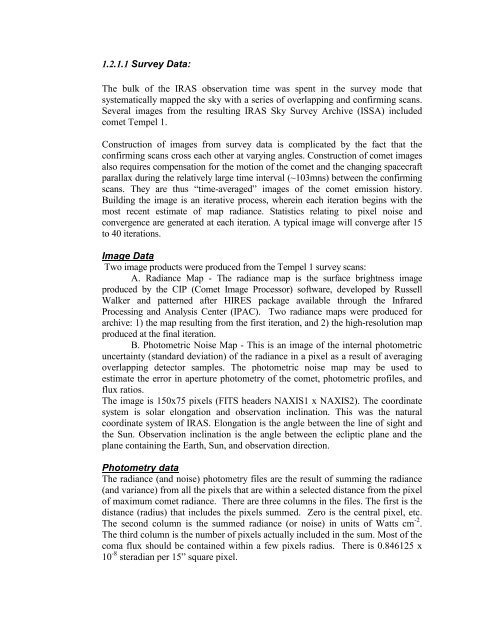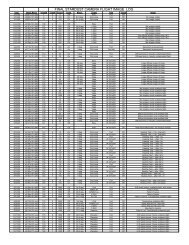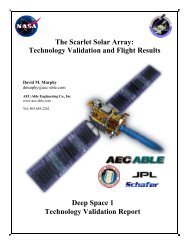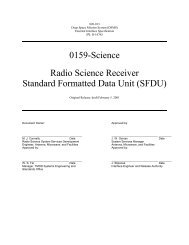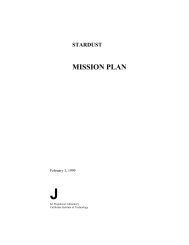PDS_VERSION_ID= PDS3 - PDS Small Bodies Node
PDS_VERSION_ID= PDS3 - PDS Small Bodies Node
PDS_VERSION_ID= PDS3 - PDS Small Bodies Node
You also want an ePaper? Increase the reach of your titles
YUMPU automatically turns print PDFs into web optimized ePapers that Google loves.
1.2.1.1 Survey Data:<br />
The bulk of the IRAS observation time was spent in the survey mode that<br />
systematically mapped the sky with a series of overlapping and confirming scans.<br />
Several images from the resulting IRAS Sky Survey Archive (ISSA) included<br />
comet Tempel 1.<br />
Construction of images from survey data is complicated by the fact that the<br />
confirming scans cross each other at varying angles. Construction of comet images<br />
also requires compensation for the motion of the comet and the changing spacecraft<br />
parallax during the relatively large time interval (~103mns) between the confirming<br />
scans. They are thus “time-averaged” images of the comet emission history.<br />
Building the image is an iterative process, wherein each iteration begins with the<br />
most recent estimate of map radiance. Statistics relating to pixel noise and<br />
convergence are generated at each iteration. A typical image will converge after 15<br />
to 40 iterations.<br />
Image Data<br />
Two image products were produced from the Tempel 1 survey scans:<br />
A. Radiance Map - The radiance map is the surface brightness image<br />
produced by the CIP (Comet Image Processor) software, developed by Russell<br />
Walker and patterned after HIRES package available through the Infrared<br />
Processing and Analysis Center (IPAC). Two radiance maps were produced for<br />
archive: 1) the map resulting from the first iteration, and 2) the high-resolution map<br />
produced at the final iteration.<br />
B. Photometric Noise Map - This is an image of the internal photometric<br />
uncertainty (standard deviation) of the radiance in a pixel as a result of averaging<br />
overlapping detector samples. The photometric noise map may be used to<br />
estimate the error in aperture photometry of the comet, photometric profiles, and<br />
flux ratios.<br />
The image is 150x75 pixels (FITS headers NAXIS1 x NAXIS2). The coordinate<br />
system is solar elongation and observation inclination. This was the natural<br />
coordinate system of IRAS. Elongation is the angle between the line of sight and<br />
the Sun. Observation inclination is the angle between the ecliptic plane and the<br />
plane containing the Earth, Sun, and observation direction.<br />
Photometry data<br />
The radiance (and noise) photometry files are the result of summing the radiance<br />
(and variance) from all the pixels that are within a selected distance from the pixel<br />
of maximum comet radiance. There are three columns in the files. The first is the<br />
distance (radius) that includes the pixels summed. Zero is the central pixel, etc.<br />
The second column is the summed radiance (or noise) in units of Watts cm -2 .<br />
The third column is the number of pixels actually included in the sum. Most of the<br />
coma flux should be contained within a few pixels radius. There is 0.846125 x<br />
10 -8 steradian per 15” square pixel.


